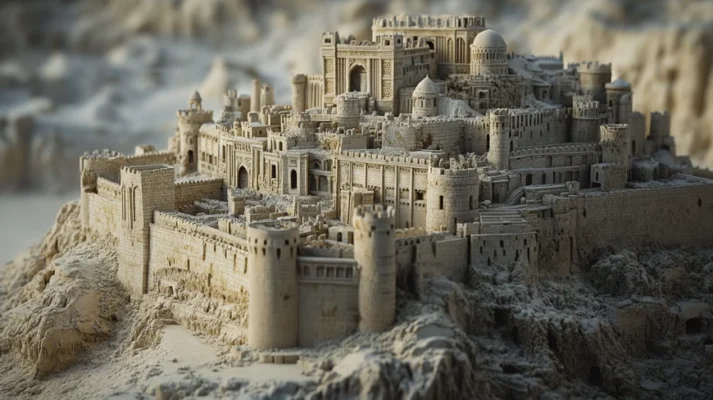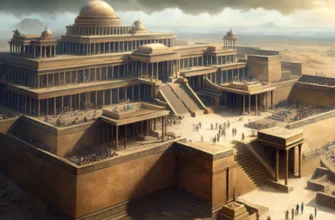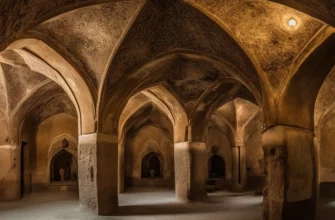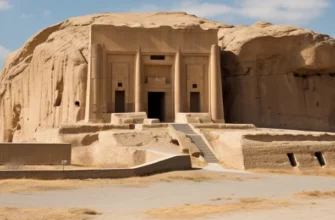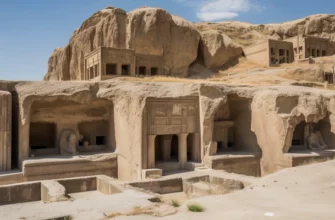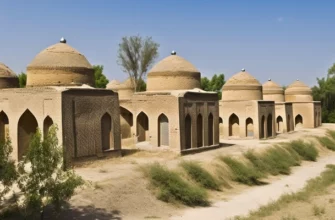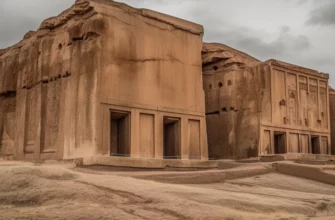Bam is an ancient city located in the Iranian province of Kerman, known for its unique architecture and centuries-old history. Its roots date back more than 2,000 years, and its heyday came during the reign of the Sassanid dynasty.
One of Bam’s most famous landmarks is the Arg-e Bam fortress, the largest structure made of unworked clay in the world. The complex had residential buildings, markets, caravanserais, and defensive walls that ensured the city’s safety and prosperity on the Great Silk Road.
In 2003, Bam was hit by a devastating earthquake that almost completely destroyed the city and the fortress. However, thanks to international efforts and UNESCO initiatives, a large-scale reconstruction began, aimed at preserving this unique cultural heritage.
Today, Bam is once again open to tourists and researchers, offering a journey into Iran’s past and the opportunity to see the grandeur of history come to life amid desert landscapes.
- History of Bam
- Foundation of the city
- First settlements and early civilizations
- Development during the Sassanid period
- Bam in the Middle Ages
- Arg-e Bam Fortress — an architectural gem
- Interior of the fortress
- The importance of Arg-e Bam in trade and defense
- Destruction of the city and fortress
- The role of Bam in Iranian culture
- Conclusion
History of Bam
Bam is one of the oldest cities in Iran, with a history dating back more than 2,000 years. Archaeological research shows that the first settlements in the Bam area appeared as early as the Achaemenid period (6th–4th centuries BC). However, the city reached its peak during the Sassanid period (3rd–7th centuries AD), when it became an important trade and cultural center on the Silk Road.
The most famous landmark of Bam is the Arg-e Bam fortress, built entirely of mud bricks. It not only served a defensive function but was also the center of city life, with bazaars, mosques, houses, and administrative buildings inside the walls.
In the Middle Ages, Bam remained an important trade center thanks to a developed network of irrigation canals (qanats) that provided water in the desert climate. However, in later centuries, with changing trade routes and political circumstances, the city gradually lost its strategic role.
The greatest blow to Bam was dealt by a devastating earthquake in December 2003, which virtually destroyed the city and the fortress. Since then, active restoration of Bam has been underway with the support of UNESCO and international partners, with the aim of preserving this unique testimony to ancient Iranian civilization.
Foundation of the city
The city of Bam was founded over two thousand years ago, approximately during the reign of the Achaemenids (6th–4th centuries BC). Its emergence was made possible by its favourable location at the crossroads of trade routes and the availability of natural resources, primarily water. To ensure life in the arid desert, the inhabitants built a complex system of underground canals, called qanats, which allowed them to effectively irrigate the land and maintain agriculture.
From the very beginning, Bam had a defensive significance: strong clay walls were built around the settlement, which later turned into a huge fortress — Arg-e Bam. Thanks to these fortifications, the city was able to protect its inhabitants from raids by nomadic tribes and at the same time serve as a stopover for merchants on the Silk Road.
The founding of Bam laid the foundation for its further development as an important cultural, economic, and strategic center in southeastern Iran.
First settlements and early civilizations
Archaeological research shows that the territory of modern Bam was inhabited as early as the Bronze Age, long before the creation of the famous urban center. The first settlements appeared here thanks to the fertile lands of the oasis and access to water through underground channels called qanats, which allowed agriculture to develop in the desert conditions.
During the Achaemenid Empire (6th–4th centuries BC), this area was already of strategic importance. The early inhabitants of Bam were engaged in agriculture, cattle breeding, and trade. Archaeologists have found the remains of residential buildings, irrigation systems, and burials here, indicating a developed social organization and religious practices.
Over time, the settlement grew, integrating into the wider trade network of ancient Iran. Thanks to its location, Bam became an important point on the future Great Silk Road, which connected the East and West.
Archaeological excavations in the Bam area have revealed numerous evidence of early life and the high level of development of local civilizations. Among the most interesting finds are:
Fragments of adobe structures demonstrating early building techniques characteristic of the desert climate.
Pottery and tableware decorated with geometric patterns, which testify to the lifestyle and artistic taste of the population.
Irrigation canals (qanats) — a complex water supply system that allowed agriculture to be practiced in arid conditions.
Burials with various accompanying items — jewelry, tools, and tableware — that provide insight into the spiritual world and social structure of the communities of that time.
Coins and seals indicate active trade and administrative control in the region.
These findings confirm that Bam has been not only a residential center since ancient times, but also an important part of the trade and cultural routes of ancient Iran.
Development during the Sassanid period
During the reign of the Sassanid dynasty (3rd–7th centuries AD), Bam experienced a period of significant growth. Thanks to its strategic location on one of the trade routes of the Great Silk Road, the city became an important economic, military, and cultural center of southeastern Iran.
It was during this period that the Arg-e Bam fortress was built, which served as a defensive structure, administrative center, and residence for the nobility. Within the fortress, there were markets, residential quarters, mosques, and warehouses for goods.
The Sassanids actively developed a system of qanats, which provided a constant water supply necessary for irrigating agricultural land and supporting the population in the harsh climate. Bam was famous for the production of silk, textiles, and dates, which were exported to various regions.
Thanks to its military strength, developed infrastructure, and thriving trade, Bam became one of the most important cities in Iran during the Sassanid period, laying the foundations for its further development in the following centuries.
Bam in the Middle Ages
In the Middle Ages (7th–15th centuries), Bam continued to be an important strategic and commercial center in southern Iran. After the Arab conquest of Persia in the 7th century, the city became part of the Muslim world and was influenced by Islamic culture. New mosques, bazaars, and caravanserais were built, testifying to the city’s active urban life.
Bam remained a key point on the trade routes through which silk, spices, dates, and handicrafts were transported.
The qezi system expanded and sustained the city even in the harsh desert conditions. However, due to political changes, wars, and destructive invasions by nomadic tribes, particularly the Mongols in the 13th century, Bam gradually lost its former importance.
Although the city suffered periodic destruction, the local inhabitants rebuilt the fortifications and continued to support trade and agriculture.
In the Middle Ages, Bam retained its fortification role: its massive mud walls still impress researchers with their strength and ingenuity. It was thanks to these fortifications that the city was able to survive difficult historical trials.
Arg-e Bam Fortress — an architectural gem
Arg-e Bam Fortress is a true architectural gem of ancient Iran and the largest structure in the world built from mud bricks. It is located on a high hill in the center of Bam and dominates the surrounding landscape.
Construction of the fortress began in the Achaemenid era, and it took its final form during the Sassanid period and subsequent Islamic dynasties. Arg-e Bam served not only as a military fortification but also as a full-fledged city with its own infrastructure: palaces, bazaars, mosques, barracks, and residential quarters.
A unique feature of the fortress is its multi-level structure, which allowed it to be defended even during prolonged sieges. Walls up to 7 meters high, powerful towers, and a labyrinth of narrow streets created a complex defense system.
Arg-e Bam impresses with its simplicity and grandeur. The use of clay as the main building material was not only ideal for the climatic conditions but also gave the fortress its characteristic warm color and natural strength.
The Arg-e Bam fortress is a true architectural gem of ancient Iran and the largest structure in the world built from mud bricks. It is located on a high hill in the center of Bam and dominates the surrounding landscape.
Construction of the fortress began in the Achaemenid era, and it took its final form during the Sassanid period and subsequent Islamic dynasties. Arg-e Bam served not only as a military fortification but also as a full-fledged city with its own infrastructure: palaces, bazaars, mosques, barracks, and residential quarters.
Interior of the fortress
Palace and residential quarters: At the heart of the fortress was a palace that served as the residence for the rulers and their families.
Its interiors were luxurious, but at the same time, the palace was a strategically important facility that ensured the safety of the ruler. Military barracks: The fortress had special rooms for accommodating soldiers and protecting them from enemy attacks.
The barracks were designed to ensure the rapid deployment of defensive forces and maintain combat readiness in the event of a prolonged siege.
Bazaar and commercial areas: Arg-e Bam was not only a military fortification but also an important trading center. The bazaar, located in the middle of the fortress, was a place for trading goods from different parts of Iran and other regions that passed through the Great Silk Road.
Water reservoirs and irrigation systems: The fortress had complex water supply systems, including underground water reservoirs that ensured water storage even during the driest periods. These reservoirs are an important element that helped to preserve the lives of the city’s inhabitants in the desert climate.
A unique feature of the fortress is its multi-level structure, which allowed it to be defended even during prolonged sieges. Walls up to 7 meters high, powerful towers, and labyrinths of narrow streets created a complex defense system.
Arg-e Bam impresses with its simplicity and grandeur. The use of clay as the main building material was not only ideal for the climatic conditions but also gave the fortress its characteristic warm color and natural strength.
Today, despite significant damage from the 2003 earthquake, the Arg-e Bam fortress remains a symbol of ancient Iranian architecture and extraordinary engineering genius.
The importance of Arg-e Bam in trade and defense
The Arg-e Bam fortress not only served as a defensive structure, but was also an important commercial and strategic center on the Great Silk Road, which connected the East and West.
Its geographical location in southeastern Iran made Bam an important stop for merchants traveling through the desert regions on their way to India, Central Asia, and Europe.
Trade and economic importance
Bam was a trading hub where goods such as silk, spices, textiles, dates, and precious stones were actively processed and exchanged. The city was an important link in a network of large markets and caravanserais connecting different parts of the world. The bazaar of the Arg-e Bam fortress was not only a place for the exchange of goods, but also a cultural center where people from different cultures and nations met.
The qezi system (underground water pipes) allowed agriculture to be maintained in the arid climate, which contributed to the development of the local economy and ensured the stability of trade supplies.
Protection and strategic importance
As a military fortress, Arg-e Bam was of great importance for the defense of southeastern Iran.
The city was located on an important route connecting Iran with Central Asia and India and could serve as a barrier to protect against attacks by nomadic tribes and enemy troops. The fortress’s powerful walls, towers, and complex labyrinths leading to it made it almost impregnable to enemies.
Arg-e Bam was not only a place of refuge for local residents, but also a strategic point that allowed control over large territories and trade routes. Its defensive structures were designed to withstand long sieges, making the fortress an important element in Iran’s defense against external forces.
The Arg-e Bam fortress not only served a defensive function but was also an important commercial and strategic center on the Great Silk Road, which connected the East and West. Its geographical location in southeastern Iran made Bam an important stop for merchants traveling through the desert regions on their way to India, Central Asia, and Europe.
Trade and economic importance
Bam was a trading hub where goods such as silk, spices, textiles, dates, and precious stones were actively processed and exchanged. The city was an important link in a network of large markets and caravanserais connecting different parts of the world. The Arg-e Bam fortress bazaar was not only a place for trading goods, but also a cultural center where people from different cultures and nations met.
The qezi system (underground water pipes) allowed agriculture to be maintained in the arid climate, which contributed to the development of the local economy and ensured the stability of trade supplies.
Defense and strategic importance
Arge Bam was important as a defensive structure. The city was located on a strategic route connecting Iran with Central Asia and India.
This made it an important link in the defense of Iran’s borders against external threats, such as raids by nomadic tribes and conquests by neighboring states.
Fortress defense system
Arg-e Bam was built to withstand the specific conditions of the desert climate and the need for long-term defense. The fortress had several levels of defense:
Walls and towers: The main defense consisted of high mud walls up to 7 meters high. Towers at the corners and along the walls provided additional height for observation and defense. This allowed control over the surrounding areas and neutralized enemy attempts to break through.
Labyrinth of streets: A complex system of narrow streets and passageways inside the fortress allowed defenders to maneuver and use the terrain to create traps for enemies.
Underground reservoirs: Water was an extremely important resource for the fortress, especially during long sieges. Arg-e Bam had a system of underground reservoirs for storing water, which allowed it to support the inhabitants and soldiers even during prolonged isolation from the outside world.
Command system: The fortress had an organized alarm system via towers, which allowed for quick notification of approaching enemies or threats.
Military campaigns and defense
Arg-e Bam became a symbol of Iranian resilience in the struggle against numerous conquerors. The fortress repeatedly served as a stronghold in defensive campaigns. It helped maintain control over trade routes, making it an important strategic target for Iranian rulers.
It is known that during the Sassanid era, as well as during periods of later conquests, Bam withstood numerous sieges, including by the Arabs and Mongols. Firearms and army maneuvers aided by strong walls were key to surviving these periods. During the siege, the city was able to survive for a long time thanks to its water and food supplies.
Thus, the Arg-e Bam fortress was not only a symbol of military power, but also an important commercial and cultural center that played a significant role in maintaining stability and development in Iran during the Middle Ages.
Destruction of the city and fortress
The earthquake that struck Bam on December 26, 2003, left the city in ruins. A powerful underground tremor measuring 6.6 on the Richter scale literally destroyed large parts of the city, including the Arg-e Bam fortress, which was one of the main symbols of Bam and an important world cultural heritage site.
Destruction of the city of Bam
Bam was one of the largest cities in southern Iran, with a population of about 100,000. After the earthquake, many of the city’s buildings were destroyed or severely damaged. Almost all residential areas, shopping areas, schools, hospitals, and public buildings were buried under rubble. The damage was so extensive that the city, which had previously been an important commercial and cultural center, was almost unrecognizable.
The total number of people who died in the earthquake was over 26,000, and thousands of people were left without a place to live. Thousands of families lost their homes, and over 50,000 people were injured.
Destruction of the Arg-e Bam fortress
The Arg-e Bam fortress, one of the largest structures in the world built from mud bricks, was also severely damaged. The tremors caused parts of the walls, towers, and residential buildings, which had existed since the Sassanid era, to collapse.
The walls, up to 7 meters high, and the towers of the fortress, which had stood for many centuries, could not withstand the force of the earthquake.
The central part of the fortress, where the palaces, administrative buildings, and residential quarters were located, was the most affected. The damage also affected unique architectural elements such as the bazaar and underground reservoirs.
Loss of cultural heritage
The destruction of Arg-e Bam was a huge loss for the world’s cultural heritage. It was not just an architectural monument, but also a testament to the thousand-year history of civilization in Iran. The fortress was added to the UNESCO World Heritage List in 2004, shortly after the earthquake, to draw attention to the need for its restoration and preservation.
Restoration
The restoration of the city of Bam and the Arg-e Bam fortress after the earthquake was a huge challenge for Iran and the international community. Scientists, architects, and engineers from around the world began working to restore Bam’s cultural heritage. The restoration process took many years and included the careful restoration of the fortress walls and the reconstruction of its historic parts.
Thanks to the efforts of international organizations, the Iranian government, and local residents, Bam and its fortress began to revive. Today, the Arg-e Bam fortress is not only a landmark that attracts tourists from all over the world, but also a symbol of hope and resilience in the face of disaster.
The role of Bam in Iranian culture
Bam is not only an important historical and architectural site, but also an important cultural center of Iran, retaining its significance for thousands of years. Located in southeastern Iran, the city was an important part of the cultural and economic map of ancient Iran. Bam played a key role in the development of not only Iran but also the entire Middle East region.
Cultural heritage and architecture
The architecture of Bam is an integral part of Iran’s cultural heritage. The Arg-e Bam fortress, which has become a symbol of the city, is one of the largest structures in the world built from mud bricks. It is a unique example of engineering and architecture that reflects the adaptation to the desert conditions of the Iranian environment. It is also a symbol of strength and stability that characterizes the history of Iran.
Thanks to its strategic location on the Silk Road, the city of Bam became an important commercial, cultural, and religious center. Bam was an important hub for the exchange of goods and ideas between East and West, which contributed to the mixing of different cultural traditions.
Influence on art and literature
Bam, thanks to its important status, has inspired many artists, poets, and writers. In the Middle Ages and the Islamic period, the city became a center for the development of local traditions in music, poetry, and the visual arts. Its magnificent architecture and cultural context influenced local art, which was expressed in numerous crafts such as carpet making, pottery, weaving, and metalworking.
Bam was also important as a religious center. Thanks to its huge mosque and other religious buildings, the city became an important part of Iran’s spiritual life, and its inhabitants participated in religious celebrations and ceremonies.
Bam on the Silk Road
As an important stop on the Silk Road, Bam became a city where different cultures and civilizations met. This contributed not only to the development of the city’s economy but also to a significant exchange of ideas between East and West. As a result, Bam became a city that symbolizes cultural diversity and international cooperation.
In the Middle Ages, Bam was a place where caravans stopped, and its market was rich in various goods, from spices to textiles. Trade not only increased the city’s prosperity but also contributed to cultural development as people from different countries exchanged knowledge and traditions.
Recovery after the earthquake
After the 2003 earthquake, which destroyed part of Bam and the Arg-e Bam fortress, the city began to recover, becoming a symbol of resilience and hope for the Iranian people. This was an important step in preserving Iran’s cultural heritage. Bam has become an example of how important it is to preserve and respect historical and cultural sites, even in the most difficult times.
Bam today
Today, Bam is not only a place that attracts tourists from all over the world with its architecture and rich history, but also an important part of Iran’s national identity. The Arg-e Bam fortress, like the city itself, is a symbol of Iranian culture, its heritage, and its ability to recover even after disasters.
Conclusion
With its centuries-old history, architectural masterpieces, and cultural significance, Bam is an important part of Iran’s and the world’s heritage. The Arg-e Bam fortress is not only a symbol of military power and strategic importance, but also a work of architectural genius that reflects adaptation to the harsh desert conditions. Bam’s location on the Great Silk Road facilitated cultural exchange, the development of art, literature, and trade, establishing the city as an important cultural and economic center.
The tragedy of the 2003 earthquake, which caused extensive damage to the city and the fortress, was a great loss for Iran and the world’s cultural heritage. However, the restoration of Bam, particularly the Arg-e Bam fortress, demonstrated the resilience and ability to restore cultural values even after enormous disasters. Today, Bam is a symbol of hope, resilience, and rebirth, as well as an important tourist and cultural site that continues to play a key role in preserving Iran’s cultural identity.
Thus, Bam will remain an important cultural, historical, and architectural site that will forever be part of the world’s heritage as a symbol of restoration and cultural interaction.
